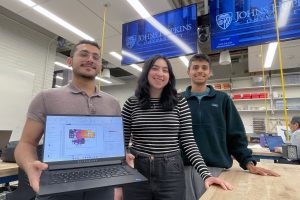
For their senior design project, teams of Civil and Systems engineering students are reimagining the Baltimore Museum of Art’s (BMA) historic Antioch Court, originally constructed in 1937 to house mosaics excavated in Antioch, Syria. While solely conceptual, the project allows students to apply engineering principles to real-world challenges. They will present their approaches at the Whiting School of Engineering’s annual Design Day on May 1.
Under the guidance of faculty members John Matteo, part-time lecturer and Principal at Matteo Ferran Structural Engineers PLLC, and Professor Tak Igusa, seniors in the Integrated Design Project class are applying structural and geotechnical engineering skills to tackle the space’s structural redesign and using systems engineering thinking and tools to improve the museum’s capacity and flow, as well as enhancing its accessibility to the broader Baltimore community.
“In the class, we provide students with real-world experiences that challenge them to integrate civil and systems perspectives. The BMA’s Antioch Court renovation offers a unique opportunity for students to incorporate both disciplines. While the project remains theoretical, its roots in the museum’s aspirations for future renovations add a layer of realism,” said Matteo. “We want students to think creatively about design solutions while considering the broader impacts, bridging theory and practice to address complex engineering challenges.”
Students are working in two teams: one focusing on the design through a systems engineering lens, and the other on the redesign of the physical structure. Though the teams are working independently, they share a common set of design objectives and are collaborating to ensure a thoughtful and holistic overall design.
Luke Gatewood, Tank Intrieri, and Ari Harris-Kupfer of the civil engineering team are tackling the court’s structural modifications. The court is currently open-air with a natural stone footpath. The team’s objectives include designing a new glass roof that retains the open-air atmosphere while protecting visitors from the elements, raising the floor to improve adjacent gallery access, and ensuring the foundation’s ability to safely support the new roof and floor designs, as well as large crowds anticipated for events.
Daniel Ardila, Kristen Corlay Sanmiguel, and Andrew Sòlanto of the systems engineering team are focusing on optimizing the court’s interior layout to accommodate more visitors and streamline crowd flow. They are also investigating ways to improve local transit to increase Baltimore community members’ accessibility to the BMA. Using modeling techniques, the team is simulating foot traffic patterns using Agent-Based Modeling—a modeling technique which simulates interactions between people, things, places, and time—to inform a strategic design that will maximize usability and accessibility, while limiting bottlenecks.
“If this were a real-life scenario, we would plan to explore feedback from visitors and museum staff on the proposed layout and usability of the space to ensure that the systems engineering portion of the project is meeting its goal of improving the space for users,” said Corlay Sanmiguel.
In addition to meeting user needs, Gatewood emphasizes the conceptual project’s broader significance, envisioning Antioch Court as a catalyst for community engagement and museum patronage.
“We’re using our knowledge of civil and systems engineering to improve accessibility and reimagine Antioch Court as a space to draw people in, in hopes that they will become future museum visitors,” he said.